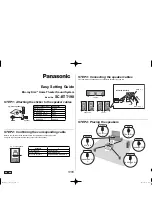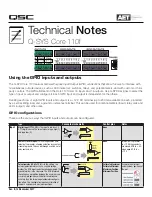
The Auto Answer/Loud Ring feature can be set to one of four modes.
0 = Disabled
: In the “Disabled” mode the phone will not automatically answer an incoming call.
CAUTION:
In the “Disabled” mode, touch tone pro-
gramming will not be possible.
1 = Auto Answer
(factory setting): In the “Auto Answer” mode the phone will automatically answer an incoming call on the first ring.
2 = Loud Ring
: In the “Loud Ring” mode the phone will not automatically answer an incoming call but will output a loud ring signal out of the speaker
in a 2 seconds on, 4 seconds off ring pattern. The call can then be answered by pressing the button.
3 = Loud Ring with AGC
: In the “Loud Ring with AGC” mode the phone will not automatically answer an incoming call but will output a loud ring
signal out of the speaker in a 2 seconds on, 4 seconds off ring pattern. The phone will automatically increase or decrease the ring volume based on
background ambient noise. The call can then be answered by pressing the button.
20. Auto Answer / Loud Ring (#33)
The “Call” LED can be programmed to one of three different modes: 0/OFF, 1/Entry Phone (factory setting), or 2/Emergency Phone.
0 = OFF Mode:
Useful for silent monitoring applications. In this mode the LED will not light during normal operation. It will only light
(blink) if it cannot register with the programmed SIP server or while manually resetting all network parameters to factory default.
1 = Entry Phone Mode:
The LED will remain ON in the idle state, turn off while button is pressed, blink during dialing, light steady
when the call is answered, then turn OFF momentarily when the call is completed.
2 = Emergency Phone Mode:
The LED will remain OFF in the idle state, blink during dialing, light steady when the call is connected,
then turn OFF when the call is completed.
3 = Emergency Phone Outbound Only:
On outbound calls, the LED will remain OFF in the idle state, blink during dialing, light
steady when the call is connected, then turn OFF when the call is completed. On in-bound calls, the LED will remain off. This is
useful for silent monitoring on inbound calls.
19. LED Mode (#32)
The Speaker Mode can be set to one of the following three modes.
0 = OFF/Silent Monitoring Mode:
In the “OFF” mode the speaker is disabled at all times. However, the speaker can be enabled
after communication has been established by entering touch tone command “
9#
”. The speaker will remain on for the duration of the
call.
1 = ON (factory setting):
In the “ON” mode the speaker is enabled during In-bound and Out-bound calls.
2 = OFF Until Answered:
In the “OFF Until Answered” mode the speaker will remain silent during dialing and will not turn on until
the called party has answered.
18. Speaker Mode (#31)
The call LED on the
E-10/20/30/32-IP
phone can be programmed to:
0 =
LED will automatically light when the distant party has answered, this is the factory default setting.
1 =
LED will light steady, only after a Touch Tone
Q
is entered from the called party.
17. “Call” LED Control (#30)
With “
Q
1” (factory default) programmed the CALL button alternately connects and disconnects calls. With “
Q
2” programmed the
CALL button connects calls only. Pressing the button again after the call has been initiated will not terminate the call.
21. Enable/Disable Alternate Switch Action (
Q
1,
Q
2)
With “
Q
6” (factory default) programmed the Remote Access Operation Commands (
Q
0 and
Q
1) to Un-Latch or Latch the relay are
enabled.
With “
Q
7” programmed the Remote Access Operation Commands (
Q
0 and
Q
1) to Un-Latch or Latch the relay are disabled. Disabling
the Latch commands can be useful in applications where you want to eliminate the possibility of inadvertently entering a latch com-
mand leaving a gate open/closed, etc.
22. Enable/Disable Relay Latching Commands (
Q
6,
Q
7)
Entering ### in programming will reset all of the Quick Programming Features back to their factory default settings.
Note:
The ###
command will not change or reset your IP settings.
23. Reset All Quick Programming Features (###)
15




































